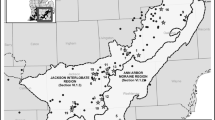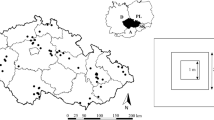Abstract
We evaluated the use of a simple rake sampling technique for predicting the biomass of submersed aquatic vegetation. Vegetation sampled from impounded areas of the Mississippi River using a rake sampling technique, was compared with vegetation harvested from 0.33-m2 quadrats. The resulting data were used to model the relationship between rake indices and vegetation biomass (total and for individual species). We constructed linear regression models using log-transformed biomass data for sites sampled in 1999 and 2000. Data collected in 2001 were used to validate the resulting models. The coefficient of determination (R 2) for predicting total biomass was 0.82 and ranged from 0.59 (Potamogeton pectinatus) to 0.89 (Ceratophyllum demersum) for individual species. Application of the model to estimate total submersed aquatic vegetation is illustrated using data collected independent of this study. The accuracy and precision of the models tested indicate that the rake method data may be used to predict total vegetation biomass and biomass of selected species; however, the method should be tested in other regions, in other plant communities, and on other species.


Similar content being viewed by others
References
Benedict, R. J. Jr. & G. R. Hepp, 2000. Wintering waterbird use of two aquatic plant habitats in a southern reservoir. Journal of Wildlife Management 64: 269–278.
Chambers, P. A. & E. E. Prepas, 1990. Competition and coexistence in submerged aquatic plant communities: the effects of species interactions versus abiotic factors. Freshwater Biology 23: 541–550.
Deppe, E. & R. C. Lathrop, 1992. A comparison of two rake sampling techniques for sampling aquatic macrophytes. Wisconsin Department of Natural Resources. Findings 32. PUBL-RS 732-92.
Downing, J. A. & M. R. Anderson, 1985. Estimating the standing biomass of aquatic macrophytes. Canadian Journal of Fisheries and Aquatic Sciences 42: 1860–1869.
Duarte, C. M., 1987. Use of echosounder tracings to estimate the aboveground biomass of submerged plants in lakes. Canadian Journal of Fisheries and Aquatic Science 44: 732–735.
Getsinger, K. D., E. G. Turner, J. D. Madsen & M. D. Netherland, 1997. Restoring native vegetation in a Eurasian water milfoil-dominated plant community using the herbicide triclopyr. Regulated Rivers: Research and Management 13: 357–375.
Jessen, R. & R. Lound, 1962. An evaluation of a survey technique for submerged aquatic plants. Minnesota Department of Conservation. Game Investigation Report 6.
Johnson, R. E. & M. R. Bagwell, 1979. Effects of mechanical cutting on submersed vegetation in a Louisiana lake. Journal of Aquatic Plant Management 17: 54–57.
Lillie, R. A., J. Budd & P. W. Rasmussen, 1997. Spatial and temporal variability in biomass density of Myriophyllum spicatum L. in a northern temperate lake. Hydrobiologia 347: 69–74.
Maceina, M. J. & J. V. Shireman, 1980. The use of a recording fathometer for determination of distribution and biomass of Hydrilla. Journal of Aquatic Plant Management 18: 34–39.
Maceina, M. J., J. V. Shireman, K. A. Langeland & D. E. Canfield Jr., 1984. Predition of submersed plant biomass by use of a recording fathometer. Journal of Aquatic Plant Mangement 22: 35–38.
Neter, J., M. Wasserman & M. Kunter, 1996. Applied Linear Regression Models, 3rd edn. Irwin, Chicago, IL, USA.
Nichols, S. A. & S. J. Rogers, 1997. Within-bed distribution of Myriophyllum spicatum L. in Lake Onalaska, Upper Mississippi River. Journal of Freshwater Ecology 12: 183–191.
Rodusky, A. J., B. Sharfstein, T. L. East & R. P. Maki, 2005. A comparison of three methods to collect submerged aquatic vegetation in a shallow lake. Environmental Monitoring and Assessment 110: 87–97.
Yin, Y., J. S. Winkelman & H. A. Langrehr, 2000. Long Term Resource Monitoring Program procedures: Aquatic vegetation monitoring. U. S. Geological Survey, Upper Midwest Environmental Sciences Center, La Crosse, WI, USA, LTRMP 95-P002-7.
Acknowledgements
We thank N. Strasser, G. Musch, R. Kreiling, R. Fox, A. Stone, A. Hartman, S. Troxell, W. Meier, and C. Beckman for their assistance with data collection and sample processing; and H. A. Langrehr and J. T. Rogala for their logistical support. We also acknowledge B. R. Gray for help with statistical methods and E. P. H. Best, D. T. Gerber, B. R. Gray, H. A. Langrehr, F. P. Meyer and several anonymous reviewers for reviewing earlier drafts of this manuscript and providing constructive comments.
Author information
Authors and Affiliations
Corresponding author
Additional information
Handling editor: S. M. Thomaz
Rights and permissions
About this article
Cite this article
Kenow, K.P., Lyon, J.E., Hines, R.K. et al. Estimating biomass of submersed vegetation using a simple rake sampling technique. Hydrobiologia 575, 447–454 (2007). https://doi.org/10.1007/s10750-006-0284-z
Received:
Revised:
Accepted:
Published:
Issue Date:
DOI: https://doi.org/10.1007/s10750-006-0284-z




